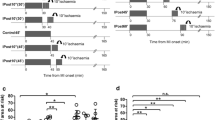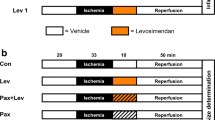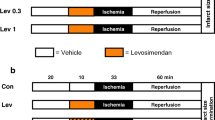Abstract
Reperfusion injury is strongly involved in the loss of functional heart tissue in patients after acute myocardial infarction. Various signal transduction pathways to reduce infarct size during reperfusion have been characterized. However, so far in the clinical setting no standard therapies are applied due to the lack of suitable drugs. Levosimendan, a calcium sensitizer, has been shown to improve survival in cardiogenic shock after infarction. Focus of the present study was to address the question, whether a bolus application of levosimendan prior to reperfusion is able to reduce the infarct size. A well-characterized model, the in vivo rat model, was used and levosimendan applied 5 min prior to reperfusion after 30-min occlusion of the left coronary artery followed by a 30-min reperfusion period. This pharmacological postconditioning was compared to the ischemic postconditioning with three times occlusion/reperfusion periods of 30 s each. To further address the question if in this in vivo model the phosphatidylinositol 3-kinase (PI3K) pathway may be involved, the PDE-III inhibiting property of levosimendan was compared to the PDE-III inhibitor enoximone. Ischemic postconditioning significantly reduced the infarct size from 48 ± 2 to 32 ± 1% of the area at risk (P < 0.05). Similarly, levosimendan decreased infarct size down to 29 ± 3%. The combination of ischemic postconditioning and pharmacological postconditioning using levosimendan did not result in a further reduction of the infarct size. Both, the mitochondrial KATP-channel blocker 5-hydroxydecanoate (5-HD) and the PI3K inhibitor wortmannin abolished the protection afforded by levosimendan completely, while the inhibitors alone did not influence the infarct size in control hearts. Pharmacological postconditioning with enoximone did not result in any infarct size reduction. Postconditioning with levosimendan significantly increased the phosphorylation of protein kinase B (Akt) and glycogen synthase kinase-3β (GSK-3β) at 5 min of reperfusion, an effect which could be blocked completely by the additional administration of wortmannin. In conclusion, levosimendan applied prior to reperfusion in acute myocardial infarction significantly reduces the infarct size in an in vivo rat model. This protection involves the PI3K pathway and the activation of mitochondrial KATP-channels, but is independent of PDE-III inhibition. This finding may open new possibilities for the treatment of patients with acute myocardial infarction using levosimendan, which is an already established therapy in cardiogenic shock. Whether the reduction of mortality in cardiogenic shock by levosimendan may in part be based on this postconditoning effect remains to be elucidated in clinical setting.







Similar content being viewed by others
References
Archan S, Toller W (2008) Levosimendan: current status and future prospects. Curr Opin Anaesthesiol 21:78–84
Cohen MV, Yang XM, Downey JM (2008) Acidosis, oxygen, and interference with mitochondrial permeability transition pore formation in the early minutes of reperfusion are critical to postconditioning’s success. Basic Res Cardiol 103:464–471
Costa AD, Jakob R, Costa CL, Andrukhiv K, West IC, Garlid KD (2006) The mechanism by which the mitochondrial ATP-sensitive K+ channel opening and H2O2 inhibit the mitochondrial permeability transition. J Biol Chem 281:20801–20808
Darling CE, Jiang R, Maynard M, Whittaker P, Vinten-Johansen J, Przyklenk K (2005) Postconditioning via stuttering reperfusion limits myocardial infarct size in rabbit hearts: role of ERK1/2. Am J Physiol Heart Circ Physiol 289:H1618–H1626
Das B, Sarkar C (2007) Pharmacological preconditioning by levosimendan is mediated by inducible nitric oxide synthase and mitochondrial KATP channel activation in the in vivo anesthetized rabbit heart model. Vasc Pharmacol 47:248–256
du Toit EF, Genis A, Opie LH, Pollesello P, Lochner A (2008) A role for the RISK pathway and K(ATP) channels in pre- and post-conditioning induced by levosimendan in the isolated guinea pig heart. Br J Pharmacol 154:41–50
du Toit EF, Muller CA, McCarthy J, Opie LH (1999) Levosimendan: effects of a calcium sensitizer on function and arrhythmias and cyclic nucleotide levels during ischemia/reperfusion in the Langendorff-perfused guinea pig heart. J Pharmacol Exp Ther 290:505–514
Edes I, Kiss E, Kitada Y, Powers FM, Papp JG, Kranias EG, Solaro RJ (1995) Effects of levosimendan, a cardiotonic agent targeted to troponin C, on cardiac function and on phosphorylation and Ca2+ sensitivity of cardiac myofibrils and sarcoplasmic reticulum in guinea pig heart. Circ Res 77:107–113
Feng J, Lucchinetti E, Ahuja P, Pasch T, Perriard JC, Zaugg M (2005) Isoflurane postconditioning prevents opening of the mitochondrial permeability transition pore through inhibition of glycogen synthase kinase 3beta. Anesthesiology 103:987–995
Follath F, Cleland JG, Just H, Papp JG, Scholz H, Peuhkurinen K, Harjola VP, Mitrovic V, Abdalla M, Sandell EP, Lehtonen L (2002) Efficacy and safety of intravenous levosimendan compared with dobutamine in severe low-output heart failure (the LIDO study): a randomised double-blind trial. Lancet 360:196–202
Fuhrmann JT, Schmeisser A, Schulze MR, Wunderlich C, Schoen SP, Rauwolf T, Weinbrenner C, Strasser RH (2008) Levosimendan is superior to enoximone in refractory cardiogenic shock complicating acute myocardial infarction. Crit Care Med 36:2257–2266
Fukasawa M, Nishida H, Sato T, Miyazaki M, Nakaya H (2008) Cilostazol, a phosphodiesterase type 3 inhibitor, reduces infarct size via activation of mitochondrial Ca2+-activated K+ channels in rabbit hearts. J Pharmacol Exp Ther 326:100–104
Garlid KD, Dos Santos P, Xie ZJ, Costa AD, Paucek P (2003) Mitochondrial potassium transport: the role of the mitochondrial ATP-sensitive K(+) channel in cardiac function and cardioprotection. Biochim Biophys Acta 1606:1–21
Gomez L, Paillard M, Thibault H, Derumeaux G, Ovize M (2008) Inhibition of GSK3beta by postconditioning is required to prevent opening of the mitochondrial permeability transition pore during reperfusion. Circulation 117:2761–2768
Gross ER, Hsu AK, Gross GJ (2008) Delayed cardioprotection afforded by the glycogen synthase kinase 3 inhibitor SB-216763 occurs via a KATP- and MPTP-dependent mechanism at reperfusion. Am J Physiol Heart Circ Physiol 294:H1497–H1500
Gross GJ, Auchampach JA (1992) Blockade of ATP-sensitive potassium channels prevents myocardial preconditioning in dogs. Circ Res 70:223–233
Haikala H, Kaivola J, Nissinen E, Wall P, Levijoki J, Linden IB (1995) Cardiac troponin C as a target protein for a novel calcium sensitizing drug, levosimendan. J Mol Cell Cardiol 27:1859–1866
Haikala H, Nissinen E, Etemadzadeh E, Levijoki J, Linden IB (1995) Troponin C-mediated calcium sensitization induced by levosimendan does not impair relaxation. J Cardiovasc Pharmacol 25:794–801
Hasenfuss G, Holubarsch C, Heiss HW, Meinertz T, Bonzel T, Wais U, Lehmann M, Just H (1989) Myocardial energetics in patients with dilated cardiomyopathy. Influence of nitroprusside and enoximone. Circulation 80:51–64
Hausenloy DJ, Mocanu MM, Yellon DM (2004) Cross-talk between the survival kinases during early reperfusion: its contribution to ischemic preconditioning. Cardiovasc Res 63:305–312
Hausenloy DJ, Ong SB, Yellon DM (2009) The mitochondrial permeability transition pore as a target for preconditioning and postconditioning. Basic Res Cardiol 104:189–202
Hausenloy DJ, Tsang A, Mocanu MM, Yellon DM (2005) Ischemic preconditioning protects by activating prosurvival kinases at reperfusion. Am J Physiol Heart Circ Physiol 288:H971–H976
Heusch G, Boengler K, Schulz R (2008) Cardioprotection: nitric oxide, protein kinases, and mitochondria. Circulation 118:1915–1919
Ito WD, Schaarschmidt S, Klask R, Hansen S, Schafer HJ, Mathey D, Bhakdi S (1997) Infarct size measurement by triphenyltetrazolium chloride staining versus in vivo injection of propidium iodide. J Mol Cell Cardiol 29:2169–2175
Kaheinen P, Pollesello P, Levijoki J, Haikala H (2001) Levosimendan increases diastolic coronary flow in isolated guinea-pig heart by opening ATP-sensitive potassium channels. J Cardiovasc Pharmacol 37:367–374
Kavianipour M, Ronquist G, Wikstrom G, Waldenstrom A (2003) Ischaemic preconditioning alters the energy metabolism and protects the ischaemic myocardium in a stepwise fashion. Acta Physiol Scand 178:129–137
Kersten JR, Montgomery MW, Pagel PS, Warltier DC (2000) Levosimendan, a new positive inotropic drug, decreases myocardial infarct size via activation of K(ATP) channels. Anesth Analg 90:5–11
Kis A, Yellon DM, Baxter GF (2003) Second window of protection following myocardial preconditioning: an essential role for PI3 kinase and p70S6 kinase. J Mol Cell Cardiol 35:1063–1071
Kopustinskiene DM, Pollesello P, Saris NE (2001) Levosimendan is a mitochondrial K(ATP) channel opener. Eur J Pharmacol 428:311–314
Lancaster MK, Cook SJ (1997) The effects of levosimendan on [Ca2+]i in guinea-pig isolated ventricular myocytes. Eur J Pharmacol 339:97–100
Mebazaa A, Barraud D, Welschbillig S (2005) Randomized clinical trials with levosimendan. Am J Cardiol 96:74G–79G
Miura T, Miki T (2008) Limitation of myocardial infarct size in the clinical setting: current status and challenges in translating animal experiments into clinical therapy. Basic Res Cardiol 103:501–513
Mocanu MM, Bell RM, Yellon DM (2002) PI3 kinase and not p42/p44 appears to be implicated in the protection conferred by ischemic preconditioning. J Mol Cell Cardiol 34:661–668
Moiseyev VS, Poder P, Andrejevs N, Ruda MY, Golikov AP, Lazebnik LB, Kobalava ZD, Lehtonen LA, Laine T, Nieminen MS, Lie KI (2002) Safety and efficacy of a novel calcium sensitizer, levosimendan, in patients with left ventricular failure due to an acute myocardial infarction. A randomized, placebo-controlled, double-blind study (RUSSLAN). Eur Heart J 23:1422–1432
Na HS, Kim YI, Yoon YW, Han HC, Nahm SH, Hong SK (1996) Ventricular premature beat-driven intermittent restoration of coronary blood flow reduces the incidence of reperfusion-induced ventricular fibrillation in a cat model of regional ischemia. Am Heart J 132:78–83
Nieminen MS, Akkila J, Hasenfuss G, Kleber FX, Lehtonen LA, Mitrovic V, Nyquist O, Remme WJ (2000) Hemodynamic and neurohumoral effects of continuous infusion of levosimendan in patients with congestive heart failure. J Am Coll Cardiol 36:1903–1912
Nishihara M, Miura T, Miki T, Sakamoto J, Tanno M, Kobayashi H, Ikeda Y, Ohori K, Takahashi A, Shimamoto K (2006) Erythropoietin affords additional cardioprotection to preconditioned hearts by enhanced phosphorylation of glycogen synthase kinase-3 beta. Am J Physiol Heart Circ Physiol 291:H748–H755
Nishino Y, Webb IG, Davidson SM, Ahmed AI, Clark JE, Jacquet S, Shah AM, Miura T, Yellon DM, Avkiran M, Marber MS (2008) Glycogen synthase kinase-3 inactivation is not required for ischemic preconditioning or postconditioning in the mouse. Circ Res 103:307–314
O’Connor CM, Gattis WA, Uretsky BF, Adams KF Jr, McNulty SE, Grossman SH, McKenna WJ, Zannad F, Swedberg K, Gheorghiade M, Califf RM (1999) Continuous intravenous dobutamine is associated with an increased risk of death in patients with advanced heart failure: insights from the Flolan International Randomized Survival Trial (FIRST). Am Heart J 138:78–86
Packer M, Carver JR, Rodeheffer RJ, Ivanhoe RJ, DiBianco R, Zeldis SM, Hendrix GH, Bommer WJ, Elkayam U, Kukin ML et al (1991) Effect of oral milrinone on mortality in severe chronic heart failure. The PROMISE Study Research Group. N Engl J Med 325:1468–1475
Pataricza J, Hohn J, Petri A, Balogh A, Papp JG (2000) Comparison of the vasorelaxing effect of cromakalim and the new inodilator, levosimendan, in human isolated portal vein. J Pharm Pharmacol 52:213–217
Piot C, Croisille P, Staat P, Thibault H, Rioufol G, Mewton N, Elbelghiti R, Cung TT, Bonnefoy E, Angoulvant D, Macia C, Raczka F, Sportouch C, Gahide G, Finet G, Andre-Fouet X, Revel D, Kirkorian G, Monassier JP, Derumeaux G, Ovize M (2008) Effect of cyclosporine on reperfusion injury in acute myocardial infarction. N Engl J Med 359:473–481
Raphael J, Rivo J, Gozal Y (2005) Isoflurane-induced myocardial preconditioning is dependent on phosphatidylinositol-3-kinase/Akt signalling. Br J Anaesth 95:756–763
Rehberg S, Ertmer C, Van Aken H, Lange M, Broking K, Morelli A, Westphal M (2007) Role of levosimendan in intensive care treatment of myocardial insufficiency. Anaesthesist 56:30–43
Rodriguez-Sinovas A, Cabestrero A, Garcia Del Blanco B, Inserte J, Garcia A, Garcia-Dorado D (2009) Intracoronary acid infusion as an alternative to ischemic postconditioning in pigs. Basic Res Cardiol
Russ MA, Prondzinsky R, Christoph A, Schlitt A, Buerke U, Soffker G, Lemm H, Swyter M, Wegener N, Winkler M, Carter JM, Reith S, Werdan K, Buerke M (2007) Hemodynamic improvement following levosimendan treatment in patients with acute myocardial infarction and cardiogenic shock. Crit Care Med 35:2732–2739
Salloum FN, Takenoshita Y, Ockaili RA, Daoud VP, Chou E, Yoshida K, Kukreja RC (2007) Sildenafil and vardenafil but not nitroglycerin limit myocardial infarction through opening of mitochondrial K(ATP) channels when administered at reperfusion following ischemia in rabbits. J Mol Cell Cardiol 42:453–458
Schulz R, Post H, Vahlhaus C, Heusch G (1998) Ischemic preconditioning in pigs: a graded phenomenon: its relation to adenosine and bradykinin. Circulation 98:1022–1029
Skyschally A, van Caster P, Boengler K, Gres P, Musiolik J, Schilawa D, Schulz R, Heusch G (2009) Ischemic postconditioning in pigs: no causal role for RISK activation. Circ Res 104:15–18
Skyschally A, van Caster P, Iliodromitis EK, Schulz R, Kremastinos DT, Heusch G (2009) Ischemic postconditioning: experimental models and protocol algorithms. Basic Res Cardiol 104:469–483
Sonntag S, Sundberg S, Lehtonen LA, Kleber FX (2004) The calcium sensitizer levosimendan improves the function of stunned myocardium after percutaneous transluminal coronary angioplasty in acute myocardial ischemia. J Am Coll Cardiol 43:2177–2182
Staat P, Rioufol G, Piot C, Cottin Y, Cung TT, L’Huillier I, Aupetit JF, Bonnefoy E, Finet G, Andre-Fouet X, Ovize M (2005) Postconditioning the human heart. Circulation 112:2143–2148
Stenslokken KO, Rutkovskiy A, Kaljusto ML, Hafstad AD, Larsen TS, Vaage J (2009) Inadvertent phosphorylation of survival kinases in isolated perfused hearts: a word of caution. Basic Res Cardiol 104:412–423
Thibault H, Piot C, Staat P, Bontemps L, Sportouch C, Rioufol G, Cung TT, Bonnefoy E, Angoulvant D, Aupetit JF, Finet G, Andre-Fouet X, Macia JC, Raczka F, Rossi R, Itti R, Kirkorian G, Derumeaux G, Ovize M (2008) Long-term benefit of postconditioning. Circulation 117:1037–1044
Tissier R, Waintraub X, Couvreur N, Gervais M, Bruneval P, Mandet C, Zini R, Enriquez B, Berdeaux A, Ghaleh B (2007) Pharmacological postconditioning with the phytoestrogen genistein. J Mol Cell Cardiol 42:79–87
Tsang A, Hausenloy DJ, Mocanu MM, Yellon DM (2004) Postconditioning: a form of “modified reperfusion” protects the myocardium by activating the phosphatidylinositol 3-kinase-Akt pathway. Circ Res 95:230–232
Ukkonen H, Saraste M, Akkila J, Knuuti J, Karanko M, Iida H, Lehikoinen P, Nagren K, Lehtonen L, Voipio-Pulkki LM (2000) Myocardial efficiency during levosimendan infusion in congestive heart failure. Clin Pharmacol Ther 68:522–531
Wagner C, Kloeting I, Strasser RH, Weinbrenner C (2008) Cardioprotection by postconditioning is lost in WOKW rats with metabolic syndrome: role of glycogen synthase kinase 3beta. J Cardiovasc Pharmacol 52:430–437
Weinbrenner C, Nelles M, Herzog N, Sarvary L, Strasser RH (2002) Remote preconditioning by infrarenal occlusion of the aorta protects the heart from infarction: a newly identified non-neuronal but PKC-dependent pathway. Cardiovasc Res 55:590–601
Wolff RA, Chien GL, van Winkle DM (2000) Propidium iodide compares favorably with histology and triphenyl tetrazolium chloride in the assessment of experimentally-induced infarct size. J Mol Cell Cardiol 32:225–232
Yang XM, Liu Y, Liu Y, Tandon N, Kambayashi J, Downey JM, Cohen MV (2009) Attenuation of infarction in cynomolgus monkeys: preconditioning and postconditioning. Basic Res Cardiol
Yang XM, Philipp S, Downey JM, Cohen MV (2005) Postconditioning’s protection is not dependent on circulating blood factors or cells but involves adenosine receptors and requires PI3-kinase and guanylyl cyclase activation. Basic Res Cardiol 100:57–63
Yang XM, Proctor JB, Cui L, Krieg T, Downey JM, Cohen MV (2004) Multiple, brief coronary occlusions during early reperfusion protect rabbit hearts by targeting cell signaling pathways. J Am Coll Cardiol 44:1103–1110
Yokoshiki H, Katsube Y, Sunagawa M, Sperelakis N (1997) The novel calcium sensitizer levosimendan activates the ATP-sensitive K+ channel in rat ventricular cells. J Pharmacol Exp Ther 283:375–383
Zhao HX, Wang XL, Wang YH, Wu Y, Li XY, Lv XP, Zhao ZQ, Zhao RR, Liu HR (2009) Attenuation of myocardial injury by postconditioning: role of hypoxia inducible factor-1alpha. Basic Res Cardiol
Acknowledgments
We thank Janet Lehmann for excellent technical assistance. This study was supported by the Roland Ernst Stiftung für Gesundheitswesen.
Author information
Authors and Affiliations
Corresponding author
Rights and permissions
About this article
Cite this article
Hönisch, A., Theuring, N., Ebner, B. et al. Postconditioning with levosimendan reduces the infarct size involving the PI3K pathway and KATP-channel activation but is independent of PDE-III inhibition. Basic Res Cardiol 105, 155–167 (2010). https://doi.org/10.1007/s00395-009-0064-9
Received:
Revised:
Accepted:
Published:
Issue Date:
DOI: https://doi.org/10.1007/s00395-009-0064-9




